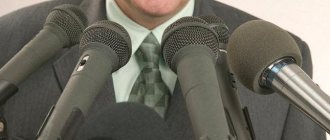Darlene Price
Business coach, author of the popular book “Well Said! Presentations and conversations that produce results.”
At the beginning of your speech, you have only 60 seconds to capture the audience's attention, gain people's trust, orient them to the topic and set them up for further listening. If you waste precious opening minutes with jokes, apologies, useless details, thank yous, or incoherent stuttering, your audience's attention will be lost forever. Get creative with your introduction. This is a difficult task for any speaker, and you will have to rehearse and perfect a catchy opening.
Tell a compelling story
Storytelling is one of the most powerful techniques. Since childhood, people love to listen and learn from stories. Fairy tale heroes, villains from campfire tales or theater characters captivate us with their dialogues, conflicts and destinies. With their help, we gain everyday experience and draw parallels with our own lives. Therefore, this technique easily holds the attention of any person.
Ideally, this should be a personal story that explains why you were puzzled by the topic of the report. Although a story about another person whom the audience might recognize would also work. Alternatively, uncover a fable, fairy tale, wisdom, or historical event.
The point is to captivate those present in 60–90 seconds and convey the key message of the entire subsequent report.
What problems did you (or someone else) encounter regarding the topic of the speech? How were they overcome? Who or what helped or hindered you? What conclusions were drawn? What should your audience get and feel after reading the story?
“Connect” between the audience and the speaker
Greeting at a public speech is one of the key elements that begins to build a connection with the audience. How to create this connection? It is important that the audience takes your side. Start with what brings you and your listeners together. Have you been to this city or lived, do you have children, are you familiar with the problem of the people in the hall? Without this there is no point in performing further. When you win people over, they won’t be so critical of your possible mistakes.
By the way, this is important. Give yourself the right to make mistakes, you are a living person. Surprisingly, this mindset will give you a feeling of freedom and you will be less likely to make mistakes.
Voice the statistics
A bold statement containing statistical data is ideal for persuading the audience to listen to your recommendations and follow them in the future. The main thing is that these numbers are directly related to the main message of your speech.
For example, the vice president of sales for a leading US healthcare company successfully markets hospital software using this method. She begins with dry but impressive numbers: “Medical errors have become the third leading cause of death after heart disease and cancer. We are talking about 400 thousand cases a year. This is much more than previously thought. We want to create a world without medical errors, and we need your help."
Good Public Speaking: 11 Simple Tips
Disclaimer
This list is not finite and does not claim to be the ultimate truth - I structured my experience of public speaking and chose the most universal tips, the implementation of which will almost guarantee that your speech will be at least good.
Structure of the report
It’s paradoxical, but many speakers, even at high-profile conferences, often do not divide their speech into three main parts - formulation of the problem, steps taken, conclusions. The structure may be more complex, but the basic structure is almost always the same, even if the conclusion is “we didn’t succeed.” The key problem for the listener is the lack of an introductory part. He can draw conclusions himself, but starting late is difficult and unpleasant. He has not yet understood that you will be talking about digestion, but he already needs to delve into the structure of the epithelium of the small intestine. The result is that your report does not reach the listener 100%, but has a chance to completely fly by.
Timing
Alas, not everyone rehearses to understand how long it will take to tell a story.
Based on the length of the presentation and even the printed report, it is extremely difficult to determine the time of the speech, unless you try to tell it to the mirror/wife/sleeping child/co-speaker. It’s unpleasant to miss the timing - you feel uncomfortable, not respecting the right of others to speak (and sometimes even have time to grab mince pies!), you start to rush and simply ruin your performance
By way of self-flagellation - I’m completely incapable of doing that either. All my reports break through any time restrictions. That's why I always try to speak last, if possible))
Who is he talking to?
Speakers love to talk to the audience with their butts and the back of their heads, or at best with their femurs and temples.
There is only one correct position for the speaker - facing the audience. To understand what is happening on the screen, or to signal to switch the slide (if suddenly there is no clicker), all you need to do is take one look and one nod of the head.
There is a problem - where to look? There are people there, and looking into their eyes is psychologically difficult for both the speaker and the victim. Life hack - choose one person in the center in the back row and look at his forehead. Why in the back - so he won’t understand that you are looking at him, the same eye position will be for the entire center of the back of the audience. Why head-on - there will be no eye contact, and you won’t confuse anyone, and at the same time, for the entire audience, you will be looking into the hall, and not at the wall/ceiling.
Yes, yes, the next point follows from this...
Don't read from screen
In addition to the mentioned disadvantage with the incorrect positioning of the speaker, reading from the screen carries with it two unpleasant consequences.
First, the speaker loses contact with the audience. If you tell people without dementia, they read silently faster than you read out loud, and they don't wait for you. You read the second point out of five and try to comment on it, but they read the fourth and don’t listen to you - they simply cannot do two things at the same time. The solution is to replace the text with images, they are perceived quickly, and the listener is all yours. “I drew a beaver here because our new component sharpens just as quickly.”
Second, the report becomes faceless. There is nothing to remember, nothing to catch your eye on. “Remember the report about pulmonary thrombus?” - “Oh, is this the one with the pictures from Doctor House?” - “Aha!” This works! “The one with blue letters on a gray background?” Camoon...
Hints
It is difficult to speak for 20 minutes on a given topic, focusing only on pictures on slides.
I've given hundreds of presentations, and every time I forget one of the good thoughts I wrote down in advance in the notes for the slide. But I forget one out of twenty, and therefore the desire to gesticulate and generally have free hands wins. I fully believe that an inexperienced speaker can forget half of it, which means that it’s impossible without hints. If reading from a screen is haram, then what? From worst to best:
- A report printed on A4 - too large sheets, small font (or a bunch of sheets), makes it difficult to read (but the goal is still to learn to speak live, with your real intonations, that is, to become a speaker, not a voice actor)
- Cramming is a solution for one report, but a long-term dead end. The process itself is unpleasant, and most importantly, it does not bring you closer to your goal; you do not improve your public speaking skills. But it looks and sounds better than frequently handling a large crumpled piece of paper.
- Short hints on the phone - access to information is not done in one action (the phone is locked, the application is minimized), you cannot tactilely control the hints while looking into the room
- The cards are about a third the size of A4, one per slide – close to ideal. On the card you can place a thumbnail of the slide (to understand what the hint is about) and several keywords - breadcrumbs that will allow you to remember the idea
- A backup monitor for a presenter is ideal. But it's not always there
For presenters using cues (except for a backup monitor), the microphone must be hands free. If for some reason it is not available, perhaps it is worth preparing the report in the time remaining before the speech so as not to fuss and spoil it.
Quality of pictures on slides
We made a slide - we moved four meters away from the laptop screen and eight meters away from the monitor. If you can't see the details, something went wrong with the slide.
Live demonstration and generally about “I’ll do everything myself”
Speaker + live software demonstration operator = dead number.
“Sooooo, now we’re going to click here...” - bad. Request help from a friend; your team is unlikely to refuse to help. Using videos instead of a live demonstration is a good option, but it also requires a separate operator, because at least at the question stage, rewinding may be necessary. The presenter should not use anything at all other than a clicker to switch slides.
Speech quality
Smooth, coherent, beautiful speech is one of the main goals of public speaking (along with showing off).
Everyone has a different starting skill, but it improves quickly at first, so the pain is worth it. If you are not sure that you can do without “uh”, “well” and pauses of 16 seconds to select a word, move on. If not, write a report on a piece of paper. Everyone’s written speech is better than oral, because what is written can be re-read and corrected, but the word is not a sparrow.
What next is up to everyone to decide, but ideally, rehearse in front of an adult (a mirror and a sleeping child will not work, you need feedback) and decide what is enough for you - skills and experience to burn from a sheet, cards with keywords, or what you still need in addition to tips Read the report 10-15 times so that its basis settles in your head.
Who is my audience?
The speaker must ask himself this question and evaluate whether his story is connecting with the audience.
Do you really need to dig very deep down to the code level or should you just talk about the profits (so that analysts and managers understand why) and invite interested programmers to talk about the details during a coffee break? Depends on what conference you're at.
Should a report on the basics of investing for an unprepared audience use the words “issuer”, “short” and talk about the positions of US presidential candidates regarding oil production? No, it looks like self-promotion, but it brings zero benefits.
Contact with the audience
It may not be worth crawling in this direction right away, but reports at an “above average” level should be accompanied by dialogue with the audience. Provoke giggles and sighs, ask rhetorical and very specific questions, do not be afraid to receive silence in response - bewilderment is also a reaction. This way, your report will settle down better in your mind, and you will get much more pleasure. Dialogue is always more pleasant than a monologue, and receiving non-verbal approval from dozens of eyes in the middle of a story is priceless; it’s an injection of dopamine directly into a drying up brain.
Author's style
If you feel that your skills are at a good average level, or you just want it, develop your own rules for designing a presentation and report.
This applies to everything - how to insert pictures and align elements on slides, what font/color to use for headings, how to format changes in content on pages, and so on. Advice - don’t get too carried away with GIFs, they unnecessarily distract from your words, especially if they are really funny. One or two per talk, and preferably either as a title card (as long as you're not saying something important), or where they illustrate a point really, really well.
And, of course, this concerns speech (although it’s much more complicated here) - how you will joke, how you will distort the language for your own purposes, what turns of phrase and memes will become your trademark and in general who you will play (after all, this is a stage, and therefore a little acting).
Let's not finish
Go in the comments to tell why my selection is not very good, and I will be happy to oppose.
Use a powerful quote
Bring words of wisdom from a famous person whose name will add weight and approval to your speech. But the quote must be relevant: meaningful and relevant to your audience.
Imagine you are persuading a group of people to reach an agreement or leading a seminar on conflict management. When starting a negotiation, you could quote the words of Mark Twain: “If two people agree on everything, one of them is not needed.” And the next sentence should encourage unity: “Even though not all of us see the way out of the problem in the same way, everyone’s efforts are extremely important in reaching an agreement.”
Basic Concepts
1. Public speaking
It is understood as a speech in front of an audience of more than three people, dedicated to a specific topic.
2. Oratory
This is the ability to speak in public. In other words, convincing people of your ideas eloquently.
In psychology, two types of oratory are distinguished.
- Natural eloquence is an innate gift - the talent to speak beautifully, convincingly and with inspiration to any audience of listeners, regardless of age, religion and gender.
- Artificial eloquence is a skill acquired in the process and during training.
“No one listens to a lecture until the professor makes a mistake.”
Weil's Law
There is also a section of literature - rhetoric. She studies oratory and all the properties and possibilities of oratory.
How to learn to speak in public: video
Show a powerful photo
A picture is worth a thousand words. And maybe more. So whenever possible, use pictures instead of text. A high-quality photo will make it easier to understand, capture the imagination of the audience and make the report more memorable.
For example, the president of an electrical equipment sales company skillfully inspired his managers to cut costs. Instead of showing them the usual charts, graphs and tables, he opened the meeting with a rather strange question: “Why did the Titanic sink?”
Everyone responded in unison about hitting an iceberg. Then the head of the company displayed an image of an iceberg on the general screen: its tip was visible above the water, but a much larger part was hidden under the surface. “The same thing awaits our company. Hidden costs are the very underwater danger that will drag us to the bottom.” This visual metaphor inspired managers, and their savings proposals ultimately saved millions of dollars.
Get a good night's sleep
Getting plenty of quality sleep is essential for public speaking.
You’ve probably noticed yourself: when you don’t get enough sleep, you feel overwhelmed, and anxiety, fear and all other impurities wake up in your head.
When you get a good night's sleep, you feel much more peaceful and refreshed.
It would be a shame to spend so much time working on your public speaking—and to let something as stupid as basic need as sleep ruin your performance.
Public speaking isn't just about secret ways to capture your audience's attention. Public speaking is the physical and mental state with which you come to perform.
Public speaking is the physical and mental state with which you come to perform.
Get at least 8 hours of sleep before a performance, this is very important. Don't let lack of sleep ruin everything
I hope your public speaking will be successful now.
The road will be mastered by those who walk, so continue to perform and make mistakes. Over time, you will become better and better at this - it's just a matter of practice.
That's why I advised you to find a job that involves public speaking. The work will give you maximum practice and development of your skills.
Remember: public speaking for an introvert is another way to conquer yourself and prove to yourself that you are capable of more.
Being an introvert should not be an excuse for the art of public speaking. Many introverts are successful public speakers, and I showed you how you can do it too.
Go ahead, friend, grow and master this cool and difficult skill - the skill of public speaking.
See you later.
Vlad Makeev.
Add visibility
To do this, use some thematic props. It grabs the audience's attention and helps emphasize your points.
For example, the head of a large insurance company, an avid tennis fan, wanted to start the annual meeting with a bang and did it with a spectacular racket swing. In this way, he expressed his determination, “won a point against his competitors,” rallied the team and ultimately “won the Grand Slam.” Over the following years, all speakers were compared to him and his ability to deliver a motivational speech.
Think about how you could use a wall clock, a colorful bag, a bunch of carrots, ball juggling, or card manipulation to engage your audience, add humor, and get your point across.
How to warm up your voice
Before you start warming up your voice, you need to stretch your vocal cords. To do this, gently press on the larynx with your thumb, and then breathe deeply into the diaphragm . How do you know if you are breathing from your diaphragm? Place your hand between your chest and stomach, then take a short breath and exhale slowly. This is similar to when we, having experienced relief, exhale in a relaxed manner, “phew.”
- By the way, such breathing is an effective technique for eliminating anxiety. As soon as you feel fear or tension, take a short breath, then exhale smoothly and you will feel much better.
Now you can move on to warming up your voice. Where do we start here? For example, from the “Om” exercise. To do this, place your hand on your head and begin to continuously pronounce the sound Om. Try to expand the volume of the larynx as much as possible until you feel vibration in your hand.
It is also good to draw out the vowels “i”, “e”, “a”, “o”, “u” (in that order and for as long as possible). Their alternate pronunciation activates blood circulation in the neck and chest. You can enhance the effect of stretching vowels if you add the “Tarzan” exercise and start beating yourself in the chest with your fist. This will not only clear the bronchi, but will also energize you before the performance.
Thus, by breathing diaphragmatically, you fill your voice with volume and strength, and by stretching the vowels, you improve its sound. However, how you sound depends largely on how you handle diction. Therefore, we move on to working on speech clarity.
Play a short video
Imagine: you start your presentation to the production department with a video in which satisfied customers give a positive review of your product. Or you open a fundraising event for endangered species with a mini-film about the Amur leopard and its offspring.
The video evokes an emotional response. Unlike words and slides, a short film engages the audience more easily, adds drama and quickly conveys the essence of what is happening.
What techniques do you use? Share in the comments.
Learning to talk to people
If for you awkwardness is the norm even in normal everyday communication with people, if you are afraid to make business calls, then try using the following ways to overcome shyness (see “10 ways to get rid of shyness and self-consciousness”):
Call for advertisements. You don't have to buy anything, just show interest and ask a few questions. Before every important call, call a friend, soak up positive emotions, and then immediately call on business.
To avoid being afraid of strangers, start communicating with them. Ask for directions on the street, say “Good afternoon!” and thanks!" In stores, check the route the bus takes.
Communicate with children, they are the most spontaneous creatures in the Universe, you definitely shouldn’t be shy about them.
Register on several forums and actively participate in discussions, express your own opinion, even if it is completely opposite to the opinion of the majority, try to provide reasoned arguments in disputes. Be sure to praise yourself and give yourself gifts if you successfully overcome an awkward situation.
And finally, most importantly, believe in your hidden strengths, because none of us is deprived of talent. Believing in the fact that you are ready to move mountains transforms your attitude towards the world, making it less aggressive.
These are a kind of “rose-colored glasses” that should be worn before important matters. And remember that initially every person treats others with goodwill, so you have nothing to be embarrassed or, especially, afraid of.






